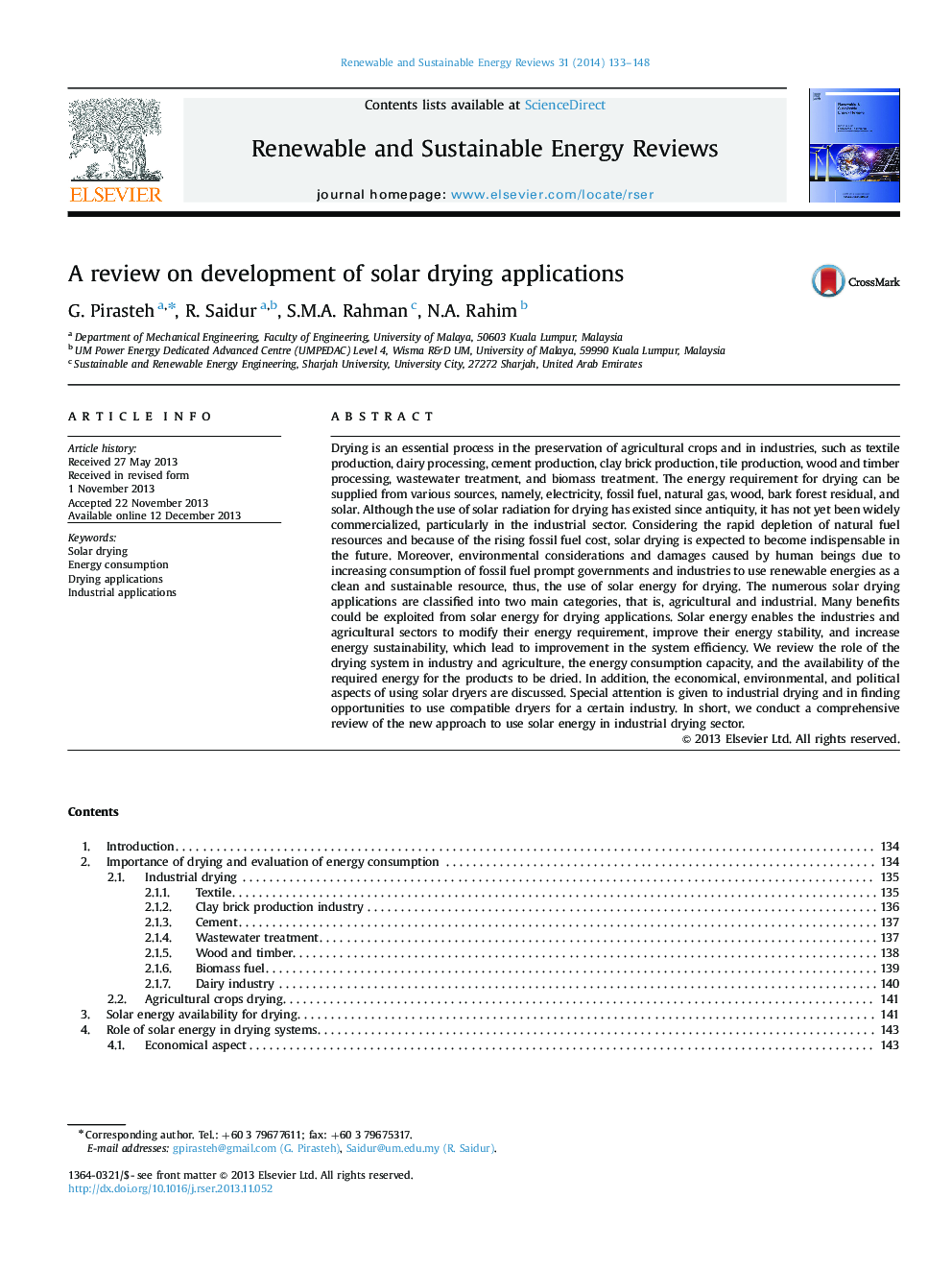| کد مقاله | کد نشریه | سال انتشار | مقاله انگلیسی | نسخه تمام متن |
|---|---|---|---|---|
| 8120220 | 1522354 | 2014 | 16 صفحه PDF | دانلود رایگان |
عنوان انگلیسی مقاله ISI
A review on development of solar drying applications
ترجمه فارسی عنوان
بررسی در مورد توسعه برنامه های خورشیدی
دانلود مقاله + سفارش ترجمه
دانلود مقاله ISI انگلیسی
رایگان برای ایرانیان
کلمات کلیدی
خشک کردن خورشیدی، مصرف انرژی، برنامه های خشک کردن، کاربردهای صنعتی،
ترجمه چکیده
خشک کردن فرآیند ضروری در حفظ محصولات کشاورزی و در صنایع مانند تولید نساجی، فرآوری لبنیات، تولید سیمان، تولید آجر خاک رس، تولید کاشی، پردازش چوب و چوب، تصفیه فاضلاب و درمان زیست توده است. انرژی مورد نیاز برای خشک کردن می تواند از منابع مختلفی از جمله برق، سوخت فسیلی، گاز طبیعی، چوب، جنگل های باقی مانده جنگل و خورشید تامین شود. اگر چه استفاده از تابش خورشیدی برای خشک شدن از زمان قدیم وجود داشته است، اما هنوز به طور گسترده ای تجدید نشده است، به ویژه در بخش صنعتی. با توجه به کاهش سریع منابع سوخت طبیعی و افزایش هزینه سوخت فسیلی، انتظار می رود خشک شدن خورشید در آینده ضروری باشد. علاوه بر این، ملاحظات زیست محیطی و آسیب های ناشی از انسان به علت افزایش مصرف سوخت های فسیلی دولت ها و صنایع سریع برای استفاده از انرژی های تجدید پذیر به عنوان یک منبع تمیز و پایدار، به این ترتیب، استفاده از انرژی خورشیدی برای خشک کردن. برنامه های خورشیدی خورشیدی متعدد به دو دسته اصلی تقسیم می شوند، یعنی کشاورزی و صنعتی. بسیاری از مزایا می تواند از انرژی خورشیدی برای خشک کردن برنامه های کاربردی استفاده شود. انرژی خورشیدی صنایع و بخش های کشاورزی را قادر می سازد تا نیاز انرژی خود را تغییر دهند، ثبات انرژی خود را بهبود بخشند و پایداری انرژی را افزایش دهند، که منجر به بهبود بهره وری سیستم می شود. ما نقش سیستم خشک کردن در صنعت و کشاورزی، ظرفیت مصرف انرژی و دسترسی انرژی مورد نیاز برای محصولات خشک شده را بررسی می کنیم. علاوه بر این، جنبه های اقتصادی، زیست محیطی و سیاسی استفاده از خشک کن های خورشیدی مورد بحث قرار گرفته است. توجه ویژه به خشک کردن صنعتی و یافتن فرصت هایی برای استفاده از خشک کن های سازگار برای یک صنعت خاص است. به طور خلاصه، ما یک بررسی جامع از رویکرد جدید استفاده از انرژی خورشیدی در بخش خشک کردن صنعتی انجام می دهیم.
موضوعات مرتبط
مهندسی و علوم پایه
مهندسی انرژی
انرژی های تجدید پذیر، توسعه پایدار و محیط زیست
چکیده انگلیسی
Drying is an essential process in the preservation of agricultural crops and in industries, such as textile production, dairy processing, cement production, clay brick production, tile production, wood and timber processing, wastewater treatment, and biomass treatment. The energy requirement for drying can be supplied from various sources, namely, electricity, fossil fuel, natural gas, wood, bark forest residual, and solar. Although the use of solar radiation for drying has existed since antiquity, it has not yet been widely commercialized, particularly in the industrial sector. Considering the rapid depletion of natural fuel resources and because of the rising fossil fuel cost, solar drying is expected to become indispensable in the future. Moreover, environmental considerations and damages caused by human beings due to increasing consumption of fossil fuel prompt governments and industries to use renewable energies as a clean and sustainable resource, thus, the use of solar energy for drying. The numerous solar drying applications are classified into two main categories, that is, agricultural and industrial. Many benefits could be exploited from solar energy for drying applications. Solar energy enables the industries and agricultural sectors to modify their energy requirement, improve their energy stability, and increase energy sustainability, which lead to improvement in the system efficiency. We review the role of the drying system in industry and agriculture, the energy consumption capacity, and the availability of the required energy for the products to be dried. In addition, the economical, environmental, and political aspects of using solar dryers are discussed. Special attention is given to industrial drying and in finding opportunities to use compatible dryers for a certain industry. In short, we conduct a comprehensive review of the new approach to use solar energy in industrial drying sector.
ناشر
Database: Elsevier - ScienceDirect (ساینس دایرکت)
Journal: Renewable and Sustainable Energy Reviews - Volume 31, March 2014, Pages 133-148
Journal: Renewable and Sustainable Energy Reviews - Volume 31, March 2014, Pages 133-148
نویسندگان
G. Pirasteh, R. Saidur, S.M.A. Rahman, N.A. Rahim,
